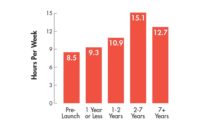Environmental Product Declarations Drive Change in Commercial Construction
Moving in the Right Direction






The more stringent requirements of the new U.S. Green Building Council’s Leadership in Energy and Environmental Design, also known as LEED, v4 rating system has raised the bar for project teams with sights set on LEED certification. The same has been true for building product manufacturers. Earlier versions of the certification allowed manufacturers to make sustainable product claims based on one attribute; while the product’s other attributes may not have made the grade. Under LEED v4, however, manufacturers are being asked to provide more detailed information on material content and comprehensive environmental impact before their individual products can be considered for a green product designation.
These changes to the rating system were designed by the council to push the commercial construction and building product industries toward more sustainable operations. One of the most discernable differences between LEED 2009 and the new LEED v4 rating systems is the demand for more transparency from manufacturers in green product claims. The best way for manufacturers to meet this demand and demonstrate their progress toward more sustainable products is to obtain an Environmental Product Declaration otherwise known as EPD.
EPDs are rigorous, third-party examinations of a product’s environmental impact throughout its life cycle that offer holistic evidence of the product’s drive toward sustainability. Together with the evolving LEED rating system, these product documents are helping drive change in the commercial construction industry today. However, why is this change so important to the industry?
Why EPDs?
As the public continues to become more educated about sustainable living, the need for transparency from manufacturers grows. Transparency helps architects and specifiers make more informed, sustainable specification decisions that put them on the track toward achieving LEED certification and a healthier building for the customer. In addition, the more sustainability-minded consumers of today are becoming more interested in the environmental impact of the products they use. According to the 2015 Corporate Social Responsibility study report from public relations and marketing agency, Cone Communications, 90 percent of consumers said they would switch from using a current brand to another brand that associates with a social or environmental cause. The study also showed that 80 percent said they seek out environmentally responsible products and 71 percent said that they are willing to pay more for a product if it was certified sustainable.
However, as consumers become more interested in sustainable products, many of them are viewing manufacturers’ sustainable product claims with suspicion. According to the same study, only 44 percent of Americans believe the sustainable product claims made by manufacturers and 77 percent said they would stop using a product if it was proved less sustainable than originally claimed. The greater transparency offered by an EPD gives proof that a manufacturer is striving to be an environmental steward and helps win the confidence of consumers.
To gain clearer understanding of the depth of transparency provided by EPDs, it is helpful to take a closer look at the process.
How EPDs are made
Manufacturers must undergo a lengthy, robust business process when developing an EPD. This starts with the selection of a program operator, an independent agency that ensures that the key steps in creating an EPD are followed in accordance with ISO standards. Next, the manufacturer must establish product category rules that follow the guidelines of industry standard ISO 14040:2006 - Environmental management—life cycle assessment—principles and framework. The manufacturer then conducts a life cycle assessment to determine the products’ overall environmental impact, create the EPD and have it verified by an independent third party, such as Underwriters Laboratory Environment, for added credibility.
Two definitive approaches taken by manufacturers in pursuit of an EPD are the cradle-to-gate approach and the cradle-to-grave approach. The cradle-to-gate evaluation of a product is the minimum allowed for an EPD under LEED v4, and examines the product’s environmental impact from raw material extraction until it reaches the “gate” of the manufacturing facility.
Manufacturers, such as CertainTeed Gypsum, however, are increasingly opting for the more robust “cradle-to-grave” approach.
In fact, CertainTeed Gypsum was the first manufacturer in the drywall category to use EPDs as a transparency vehicle. The cradle-to-grave approach is based on a full life cycle assessment that examines the product’s environmental impact at each stage of its life cycle, from “cradle to grave.” For example, life cycle assessments for a building product would likely report on the environmental impacts tied to raw material extraction and transportation, product manufacturing, use phase, and the product’s end of life.
Therefore, compared to the cradle-to-grave approach, the cradle-to-gate evaluation gives a very limited view of a product’s overall environmental impact. Project teams that seek out products with cradle-to-grave EPDs during specification are better able to understand the full environmental impact picture, from raw material extraction to product end of life. They can then make more sustainable decisions accordingly.
How EPDs Help Earn LEED Credits
There are varieties of categories under LEED v4 where specifiers can maximize their credits by selecting products that have EPDs. The first and most common way to achieve LEED credits is under LEEDv4 Materials and Resources Credit (MR credit 2) – EPD. This credit requires that a project team specify 20 different products that have EPDs, sourced from at least five different manufacturers. The availability of manufacturer-specific EPDS enables the architect or specifier to achieve this credit, as defined in LEED v4 requirements.
The second way a project team can achieve LEED credits under MR credit 2 is to specify products with multiple sustainable attributes. This strategy is intended to reward manufacturers for using EPD documents as a playbook for sustainable product innovation by showing environmental impact reduction, or performance improvement, below industry average or across iterations of a manufacturer-specific EPD in at least three of the environmental impact categories measured in an EPD. Those categories measure product impact on factors such as global warming potential or depletion of non-renewable energy resources. For more information on how to earn credits under MR credit 2, go to usgbc.org.
LEED v4 also awards pilot credits for actions and projects that the USGBC consider innovative, but have not been formally approved as a standard credit in their rating system. MRpc84 Materials Multi-Attribute Assessment – EPDs, formerly known as Pilot Credit 52, was added to LEED 2009 with the introduction of LEEDv4. This credit in LEED 2009 mirrors the MR Credit 2, Option 1 credit from LEED v4, which incentivizes projects that specify at least 20 different products that have EPDs, sourced from at least five different manufacturers, in the same way as it is achieved in the LEED v4 system. For more information on either of these credits, specifiers can visit the USGBC website.
Conclusion
It is true that EPDs are helping drive change within the manufacturing sector and the commercial construction industry, challenging stakeholders to step up and do their part for environmental stewardship. As more manufacturers continue to develop cradle-to-grave EPDs and more project use products that carry the EPD label, the sustainable construction movement will continue to grow in the right direction for years to come.
Looking for a reprint of this article?
From high-res PDFs to custom plaques, order your copy today!












